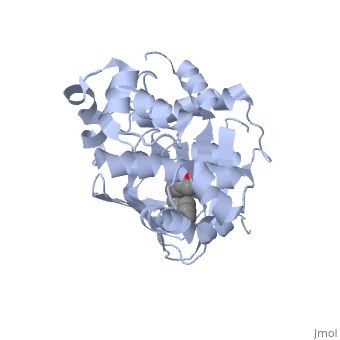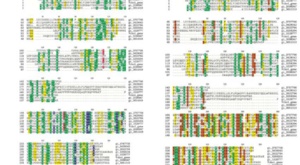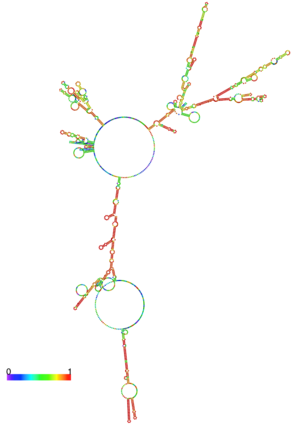ToxT
From Proteopedia
(Difference between revisions)
| (One intermediate revision not shown.) | |||
| Line 1: | Line 1: | ||
<StructureSection load='3gbg' color='structure' size='350' frame='true' side='right' caption='ToxT complex with palmitoleic acid, 1.9 Angstrom resolution crystal structure, [[3gbg]]' > | <StructureSection load='3gbg' color='structure' size='350' frame='true' side='right' caption='ToxT complex with palmitoleic acid, 1.9 Angstrom resolution crystal structure, [[3gbg]]' > | ||
| + | __TOC__ | ||
The crystal structure of ToxT is resolved in monomeric form, after isolation from <i>Vibrio cholerae</i> strain O395.<ref name="structure">PMID: 20133655</ref> | The crystal structure of ToxT is resolved in monomeric form, after isolation from <i>Vibrio cholerae</i> strain O395.<ref name="structure">PMID: 20133655</ref> | ||
==Introduction== | ==Introduction== | ||
| - | <b>ToxT</b> is a molecule at the end of a transcriptional cascade that autoregulates the transcription of the primary virulence factors of <i>Vibrio cholerae</i>[http://en.wikipedia.org/wiki/Vibrio_cholerae] and itself. ToxT is a cytoplasmic protein that is activated in turn by ToxR, which is itself activated by ToxS in response to environmental stimuli.<ref>Kenneth Todar [http://www.textbookofbacteriology.net/cholera.html] ''Vibrio cholerae'' and Asiatic Cholera, Todar's Online Textbook of Bacteriology. Date of access: 2011-11-28.</ref> These two factors, cholera toxin (CT)[http://en.wikipedia.org/wiki/Cholera_toxin] and the toxin co-regulated pilus (TCP), are instrumental in causing the disease <b>cholera</b>[http://en.wikipedia.org/wiki/Cholera]. This is an intestinal infection resulting in massive water loss in the affected individual, causing extreme dehydration.[http://en.wikipedia.org/wiki/Cholera] Rehydration is sufficient as treatment. | + | <b>ToxT</b> or '''toxin co-regulated pilus virulence regulatory protein''' is a molecule at the end of a transcriptional cascade that autoregulates the transcription of the primary virulence factors of <i>Vibrio cholerae</i>[http://en.wikipedia.org/wiki/Vibrio_cholerae] and itself. ToxT is a cytoplasmic protein that is activated in turn by ToxR, which is itself activated by ToxS in response to environmental stimuli.<ref>Kenneth Todar [http://www.textbookofbacteriology.net/cholera.html] ''Vibrio cholerae'' and Asiatic Cholera, Todar's Online Textbook of Bacteriology. Date of access: 2011-11-28.</ref> These two factors, cholera toxin (CT)[http://en.wikipedia.org/wiki/Cholera_toxin] and the toxin co-regulated pilus (TCP), are instrumental in causing the disease <b>cholera</b>[http://en.wikipedia.org/wiki/Cholera]. This is an intestinal infection resulting in massive water loss in the affected individual, causing extreme dehydration.[http://en.wikipedia.org/wiki/Cholera] Rehydration is sufficient as treatment. |
==Structural Features== | ==Structural Features== | ||
<u>DNA-binding</u>. ToxT belongs to a family of transcriptional regulators headed by and known as AraC.<ref name="structure">PMID: 20133655</ref> The AraC family is characterized by a 100 amino acid region of sequence similarity that forms a <scene name='ToxT_Transcriptional_Regulator_in_Vibrio_cholerae/Two_hth_domains/1'>DNA-binding domain</scene> with two helix-turn-helix motifs (one on either side of the black linker). <ref name="arac">PMID: 11282467</ref> This DNA binding domain is composed of seven alpha helices. HTH1 is composed of alpha helices five and six, while HTH2 is composed of alpha helices eight and nine. The two HTH regions are linked by the very polar alpha helix seven(shown in black). The overall domain is located at the C-terminus.<ref name="structure">PMID: 20133655</ref> Assuming ToxT is similar in mechanism to other AraC proteins, helix six from HTH1 and helix nine from HTH2 become aligned with the help of helix seven. Helix seven is positioned to attach to the N terminal binding pocket(the polar linking region) to allow binding to major consecutive grooves of target DNA (specific promoters for virulence genes).<ref name="structure">PMID: 20133655</ref>[http://www.pnas.org/content/107/7/2860/F3.large.jpg]. The conformation of helix seven is dependent on the ligand bound. | <u>DNA-binding</u>. ToxT belongs to a family of transcriptional regulators headed by and known as AraC.<ref name="structure">PMID: 20133655</ref> The AraC family is characterized by a 100 amino acid region of sequence similarity that forms a <scene name='ToxT_Transcriptional_Regulator_in_Vibrio_cholerae/Two_hth_domains/1'>DNA-binding domain</scene> with two helix-turn-helix motifs (one on either side of the black linker). <ref name="arac">PMID: 11282467</ref> This DNA binding domain is composed of seven alpha helices. HTH1 is composed of alpha helices five and six, while HTH2 is composed of alpha helices eight and nine. The two HTH regions are linked by the very polar alpha helix seven(shown in black). The overall domain is located at the C-terminus.<ref name="structure">PMID: 20133655</ref> Assuming ToxT is similar in mechanism to other AraC proteins, helix six from HTH1 and helix nine from HTH2 become aligned with the help of helix seven. Helix seven is positioned to attach to the N terminal binding pocket(the polar linking region) to allow binding to major consecutive grooves of target DNA (specific promoters for virulence genes).<ref name="structure">PMID: 20133655</ref>[http://www.pnas.org/content/107/7/2860/F3.large.jpg]. The conformation of helix seven is dependent on the ligand bound. | ||
| Line 16: | Line 17: | ||
==Ligand== | ==Ligand== | ||
In this resolved structure, <scene name='ToxT_Transcriptional_Regulator_in_Vibrio_cholerae/Pam/2'>cis-palmitoleate</scene>[http://www.ebi.ac.uk/thornton-srv/databases/cgi-bin/pdbsum/GetPage.pl?pdbcode=3gbg&template=ligands.html&l=1.1] is shown, which can be bound in the beta sheet barrel (as discussed above). This unsaturated fatty acid reduces virulence expression in <i>Vibrio cholerae</i>. | In this resolved structure, <scene name='ToxT_Transcriptional_Regulator_in_Vibrio_cholerae/Pam/2'>cis-palmitoleate</scene>[http://www.ebi.ac.uk/thornton-srv/databases/cgi-bin/pdbsum/GetPage.pl?pdbcode=3gbg&template=ligands.html&l=1.1] is shown, which can be bound in the beta sheet barrel (as discussed above). This unsaturated fatty acid reduces virulence expression in <i>Vibrio cholerae</i>. | ||
| - | + | ||
==Further Study== | ==Further Study== | ||
Conclusive results about what activates ToxT itself has not yet been found. The varying activity of ToxT dependent on the presence of <i>cis</i>-palmitoleate or other unsaturated fatty acids represents a detailed method of effective pathogenicity in humans, but may not be a reasonable target for drug treatment. By restricting transcription (and thus translation and protein production) of virulence genes until the bacterium is determined to be in a favorable location for infection, <i>Vibrio cholerae</i> avoids wasting energy producing virulence factors that will just be cleared by the intestine. This is a specific mechanism to ensure that the bacterium also injects CT and TCP where they will do the most damage, perpetuating the infection. <ref>Kenneth Todar [http://www.textbookofbacteriology.net/cholera.html] ''Vibrio cholerae'' and Asiatic Cholera, Todar's Online Textbook of Bacteriology. Date of access: 2011-11-28.</ref> Despite the lack of information about what activates ToxT itself, it is understood that the transcription of ctxA and tcpA by vibrio cholerae is sharply reduced in the presence of oleic, linoleic acid, and arachidonic acid, all of which are components of bile. Therefore, one may hypothesize that it may be possible to use the structure of a UFA or SFA to design a small molecule inhibitor of ToxT which may be used to treat or prevent cholera. | Conclusive results about what activates ToxT itself has not yet been found. The varying activity of ToxT dependent on the presence of <i>cis</i>-palmitoleate or other unsaturated fatty acids represents a detailed method of effective pathogenicity in humans, but may not be a reasonable target for drug treatment. By restricting transcription (and thus translation and protein production) of virulence genes until the bacterium is determined to be in a favorable location for infection, <i>Vibrio cholerae</i> avoids wasting energy producing virulence factors that will just be cleared by the intestine. This is a specific mechanism to ensure that the bacterium also injects CT and TCP where they will do the most damage, perpetuating the infection. <ref>Kenneth Todar [http://www.textbookofbacteriology.net/cholera.html] ''Vibrio cholerae'' and Asiatic Cholera, Todar's Online Textbook of Bacteriology. Date of access: 2011-11-28.</ref> Despite the lack of information about what activates ToxT itself, it is understood that the transcription of ctxA and tcpA by vibrio cholerae is sharply reduced in the presence of oleic, linoleic acid, and arachidonic acid, all of which are components of bile. Therefore, one may hypothesize that it may be possible to use the structure of a UFA or SFA to design a small molecule inhibitor of ToxT which may be used to treat or prevent cholera. | ||
| Line 32: | Line 33: | ||
[[3gbg]], [[4mlo]] - VcToxT - ''Vibrio cholerae''<br /> | [[3gbg]], [[4mlo]] - VcToxT - ''Vibrio cholerae''<br /> | ||
| + | [[6p7t]] - VcToxT (mutant)<br /> | ||
| + | [[6p7r]] - VcToxT + fatty acid<br /> | ||
| + | [[6pb9]] - VcToxT (mutant) + fatty acid<br /> | ||
[[5suw]], [[5sux]] - VcToxT + naphthalene derivative<br /> | [[5suw]], [[5sux]] - VcToxT + naphthalene derivative<br /> | ||
| Line 49: | Line 53: | ||
Bailey, C; Camilla. Boedeker, C; Edgar. Johnson, A; Judith. Kaper, B; James. Karaolis, R; David. Reeves, R; Peter. (1997). “A Vibrio cholerae pathogenicity island associated with epidemic and pandemic strains.” March 17, 1998 vol. 95 no. 6 3134-3139 | Bailey, C; Camilla. Boedeker, C; Edgar. Johnson, A; Judith. Kaper, B; James. Karaolis, R; David. Reeves, R; Peter. (1997). “A Vibrio cholerae pathogenicity island associated with epidemic and pandemic strains.” March 17, 1998 vol. 95 no. 6 3134-3139 | ||
| + | </StructureSection> | ||
[[Category:Topic Page]] | [[Category:Topic Page]] | ||
Current revision
| |||||||||||
Proteopedia Page Contributors and Editors (what is this?)
Ingrid Youngworth, Yang Yang, Michal Harel, Alexander Berchansky, Jaime Prilusky



